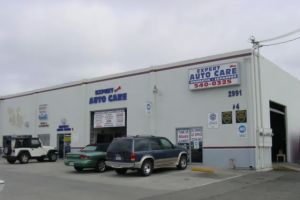How to Handle a Blowout When Traveling with Passengers: Expert Tips for Staying Safe and Calm
When I first experienced a tire blowout on a highway with passengers in the car, I was caught off guard. One minute, everything was fine, and the next, my car started to wobble uncontrollably. I had a full car with family members and friends, and the sense of urgency was overwhelming. Fortunately, my quick thinking and some lessons learned along the way helped me manage the situation safely. In this article, I’m going to share what I’ve learned about handling a blowout while traveling with passengers, the steps to take, and how to stay calm in the midst of chaos.

Expert Auto Care
2991 Grace Ln #4, Costa Mesa, CA 92626, USA
1. Recognizing the Symptoms of a Blowout
Before we get into what to do after a blowout, it’s essential to understand the signs that you might be dealing with one. A blowout doesn’t always happen suddenly without warning. In my case, there was a brief moment when I could feel the car pulling to one side, which was a sign of an underinflated or punctured tire. If you feel a sudden, sharp thumping or the car swaying to one side, these could be indicators that a blowout is imminent.
During the blowout itself, you may hear a loud pop or hissing noise. If you’re driving at high speeds, this noise can be terrifying, but the most important thing to remember is that you must remain calm and keep control of the vehicle. This is one of the key lessons I learned—staying calm is essential for both your safety and the safety of your passengers.

AJ's Auto Glass & Detailing
4404 S 84th St, Omaha, NE 68127, USA
2. Keep Your Cool and Maintain Control
The moment I realized I was having a blowout, my heart started racing, but I knew I had to stay calm for everyone in the car. If you panic and slam on the brakes or oversteer, you can lose control of the vehicle, which is the last thing you want, especially when you have passengers. What I did was focus on staying steady and keeping the car under control.
First, I kept both hands on the wheel and gently steered the car straight, making sure I wasn’t overcompensating by turning the wheel. I avoided slamming on the brakes, as that could cause the car to skid. Instead, I allowed the car to slow down gradually, giving me more time to find a safe place to pull over. I also had to remind my passengers to stay calm, as the situation could be unnerving for them as well.
It’s critical not to panic in a blowout situation. The more you can keep your head, the more likely you are to handle the blowout successfully without further danger.
3. Safely Pull Over to the Side of the Road
Once I had the car under control, my next priority was getting off the road as quickly and safely as possible. Finding a safe location to pull over is one of the most important things you can do. If you’re on a highway or busy road, the shoulder is usually the best place to go. However, if there is no shoulder or if the shoulder isn’t wide enough, it’s crucial to make sure you’re as far from traffic as possible.
I made sure to signal my intentions by using the turn signal well in advance. After pulling over, I placed the car in park and engaged the emergency brake to prevent it from rolling. I also turned on my hazard lights immediately to alert other drivers of my situation. This is important not just for your safety, but for the safety of your passengers, too.
4. Check on Passengers and Assess the Situation
At this point, the situation wasn’t over, and I had to make sure my passengers were okay. I reminded everyone to stay in the car, as it’s safer to be inside the vehicle while waiting for assistance, especially if you’re on a busy highway or road. I checked in with everyone to ensure no one was feeling unwell or scared, especially the children who were in the back seat.
I then took a quick assessment of the situation. I checked my car to make sure it was still safe to exit, considering the proximity to traffic. I made sure my own safety and that of my passengers was the priority before making any further decisions. Once everyone was okay, I turned my attention to the tire situation.
5. Assess the Damage and Decide Whether to Change the Tire or Call for Help
Now, I had to decide whether I could change the tire myself or if I needed professional help. I always carry a spare tire, a jack, and a lug wrench in the trunk, so I was prepared to do it myself. But depending on the severity of the blowout or the condition of your spare tire, you might not be able to change it yourself. In that case, it’s better to call for towing assistance. If you’re in an area where it’s not safe or if you feel uncomfortable changing the tire, don’t hesitate to call a towing company.
For me, the damage to the tire was significant, but I was able to assess that the tire change was manageable. I knew that I had to make sure I was in a safe location before attempting anything. That’s when I remembered how crucial it is to have access to a towing company for situations like this, where immediate help is needed. Even though I was capable of handling the situation, knowing that I could call for assistance gave me peace of mind.
6. Using Towing Assistance: When You Need Professional Help
There are times when calling for professional help is the smartest decision. If you’re unsure about your ability to change the tire safely, or if you’re in an isolated area, don’t risk it. I’ve been in situations where it was easier to call for towing assistance, and I don’t regret it. Especially in remote areas or after dark, towing services are crucial for your safety and for getting back on the road quickly.
In these moments, I’ve always trusted Rescue & Towing, which has been an excellent resource when I needed quick help. They provide emergency towing and roadside assistance, ensuring you’re never stranded for long. Whether you need a tire change, battery jump, or just a safe tow, they’ve got your back, and I can’t recommend them enough for their professionalism and speed.
7. Avoid Future Blowouts: How to Prevent Them on Long Trips
While blowouts are sometimes unavoidable, there are several preventive measures you can take to reduce the risk of experiencing one. From my experience, one of the best things you can do is ensure your tires are properly maintained before any long trip. I make it a habit to check my tire pressure regularly, especially before heading out on a long drive. Underinflated tires are more likely to blow out, so it’s crucial to keep your tires properly inflated at all times.
Additionally, I’ve learned to inspect the condition of my tires, looking for any signs of wear, punctures, or cracks. If I notice anything suspicious, I get it checked out by a professional before hitting the road. I also recommend replacing tires that are too old, as they are more prone to failure. Regular maintenance of the tires, along with proper alignment and balancing, can go a long way in preventing blowouts.
If you find yourself in a situation where you do need help, always keep a reliable towing company like Rescue & Towing in mind. They’ll be there when you need them the most, and you’ll feel at ease knowing you have expert help just a phone call away.























